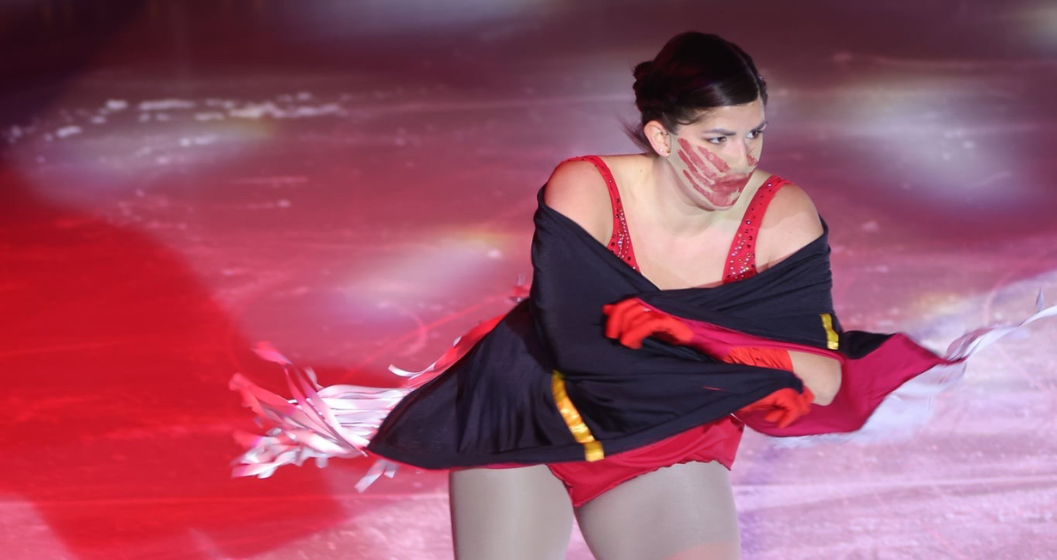Skating with Purpose: Sharing Indigenous Culture on the Ice
Figure skating is more than just a sport for Amber Brennan — it’s a powerful outlet for cultural expression and a way to share her First Nations identity. As an outgoing and active child, Amber laced up her first pair of skates at the age of four at the Élan de Maniwaki Figure Skating Club in Maniwaki, Quebec. From the beginning, she was passionate about both the technical and artistic elements of the sport.
Her creativity truly began to blossom at age 14 when she started choreographing her own competitive programs. This gave her the opportunity to connect movement with music in a way that reflected her identity. Although it came with a learning curve, Amber honed her skills by watching YouTube videos and working closely with her coach, Gordon Forbes, after moving to the Minto Skating Club in Ottawa, Ontario.

Amber Brennan at the 2025 Quebec STARSkate Championships.
Over time, choreography evolved from a creative outlet into a powerful tool for Amber to share her culture and spark dialogue around important issues. At the 2025 Élan de Maniwaki Club’s Skating Show, she performed a moving routine inspired by Red Dress Day, an initiative that raises awareness about the crisis of missing and murdered Indigenous women, girls, and two-spirit people (MMIWG2S+). Initially, Amber just wanted to incorporate traditional First Nations dances into her performance because she hadn’t seen other Indigenous skaters doing so. But as the piece developed, she realized it could be much more impactful.
Amber didn’t just skate — she told a story. Wearing a Fancy Shawl made by her mother, she embodied a symbol of transformation, representing a butterfly emerging from its cocoon. The shawl was black on the outside and red on the inside. At the end of the performance, she flipped it inside out, symbolizing strength, unity, and solidarity with Indigenous communities affected by violence. “In our culture, even if you’re from a different tribe or reserve, we come together to support each other,” Amber explained.
The music she skated to, which featured traditional drumming, added another layer of meaning. “The drum is more than music. It’s a heartbeat. A call to remember who we are.”
The emotional performance deeply resonated with the audience. Indigenous community members approached Amber afterward to thank her, while non-Indigenous attendees expressed support and a desire to learn more. Amber emphasized how important these conversations are — especially since, in her own lived experience, topics like this were rarely discussed outside of her community. As an Indigenous person, she continues to learn from her community and recognizes the importance of amplifying these stories.
“I skate for those who were taken. We move for those whose stories were never known or told. We carry their memory forward with every beat, every step, every glide, and every breath.”
For Amber, sharing her culture through figure skating is also a way to strengthen Indigenous representation in the sport, something she’s experienced the power of firsthand. “When I was younger, I never really looked for another Native skater,” she said. That changed in 2023 at the Canadian National Skating Championships in Oshawa, Ontario, when she saw ice dancer Nathan Lickers proudly wearing a beaded medallion to honor his Indigenous identity. Amber and her mom were thrilled. “It was exciting to see another Indigenous person representing their culture in figure skating.”
Since then, Amber has made it her mission to be a source of inspiration for others. She posted a video of her Red Dress Day performance on YouTube, hoping it might resonate with young Indigenous skaters.
“Maybe someone will see it and say, ‘Mom, I want to do that too,” she said. “It shows that this space can be welcoming for Native skaters.”
Amber is already making a difference close to home. She grew up on the Kitigan Zibi reserve, located beside the town where her first skating club is based, and young Indigenous girls at the club often approach her to share how much they love skating. “They look up to me,” she shared. “I think it’s just seeing someone else who is Native doing it, it makes them feel it’s possible for them too.”
By weaving Indigenous traditions, symbolism, and advocacy into her performances, Amber is not only creating space for meaningful conversations but also showing that identity and artistry can go hand in hand. Her performances demonstrate that figure skating can be a bridge — connecting communities, raising awareness, and celebrating the strength and richness of Indigenous cultures.
Thanks to the leadership and collaboration of Indigenous communities, Skate Canada has been able to create more opportunities for all people to participate in the joy of skating through initiatives like the Community Constellation program and World Ice Skating Day activations.
